How Many Cats & Dogs Are Spayed & Neutered in the US? Statistics to Know in 2024
By Jessica Kim
Updated on
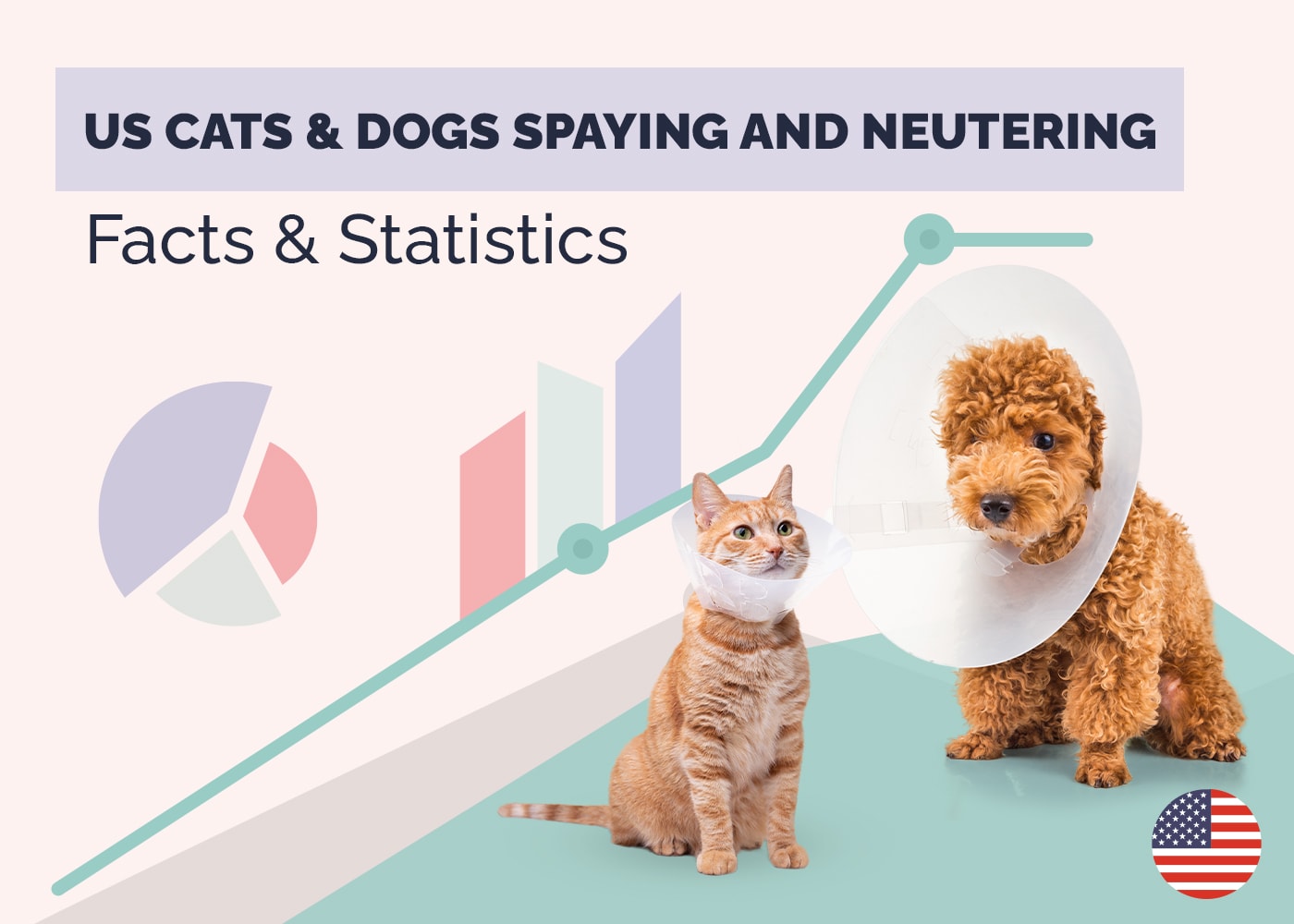
Click to Skip Ahead
Note: This article’s statistics come from third-party sources and do not represent the opinions of this website.
Spaying and neutering are recommended by many professionals in the pet and veterinary care field, including animal rescues and veterinarians. If you don’t plan to breed your cats or dogs, spaying and neutering can benefit their overall quality of life and reduce overcrowding in animal shelters.
However, newer research is showing that the timing of spay and neuter procedures is important. Uncareful consideration of the animal’s age and sexual maturity may put it at higher risk of developing health issues later down the road.
It’s important for pet owners to put thoughtful consideration into spaying and neutering their cats or dogs. Here’s the latest information on spaying and neutering and their effects on cats and dogs.
The 12 Cats & Dogs Spaying and Neutering Statistics
- About 90% of adopted cats and dogs in the US are neutered or spayed.
- 32 states legally require adopted pet cats and dogs to be sterilized.
- Spaying and neutering cost between $320 and $550 from a private clinic.
- Approximately 6.3 million animals enter animal shelters annually.
- About 920,000 shelter animals are euthanized annually.
- The percentage of stray cats entering shelters lowered from 54% to 50% in 2022.
- Almost 5,000 kittens can be born from one unspayed female cat in 7 years.
- 75% of bite reports involve an intact male dog.
- 85% of dogs hit by cars haven’t been spayed or neutered.
- Neutered dogs live 18% longer and spayed female dogs live 23% longer than dogs that haven’t been sterilized.
- Dogs that are spayed before their first heat cycle have an 0.5% increased risk of developing mammary cancer.
- Male Golden Retrievers that were neutered before 12 months old were twice less likely to develop hip dysplasia than intact males.
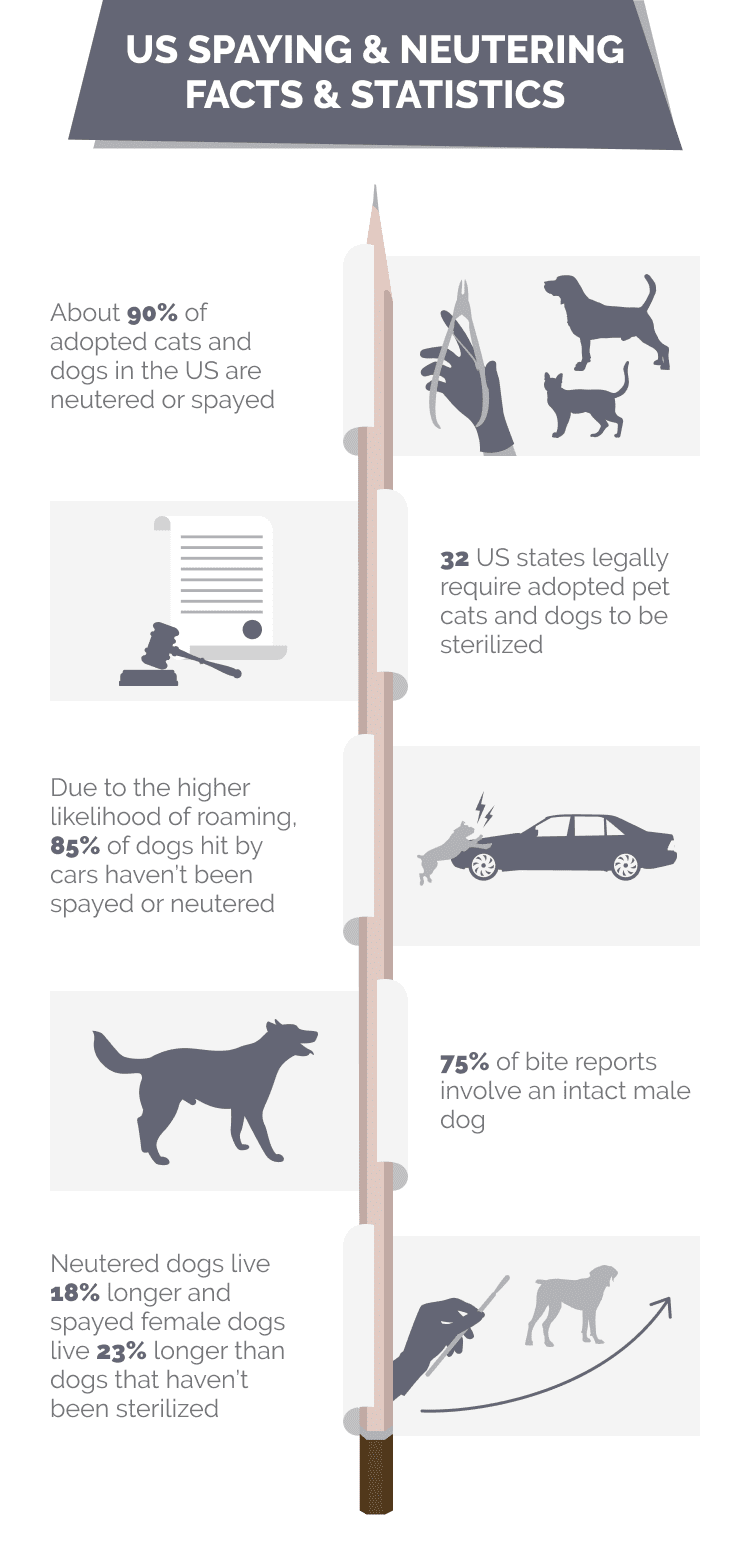
 Culture of Spaying & Neutering Cats & Dogs in the US
Culture of Spaying & Neutering Cats & Dogs in the US
1. About 90% of adopted cats and dogs in the US are neutered or spayed.
(The Humane Society)
Spaying and neutering cats and dogs are common practices in the US and have become the norm for most pet owners. Much research to support the benefits of spaying and neutering encourages experts in the field to continue promoting these procedures. Spaying and neutering help control the population of stray animals and can lower the rates of euthanizing them.
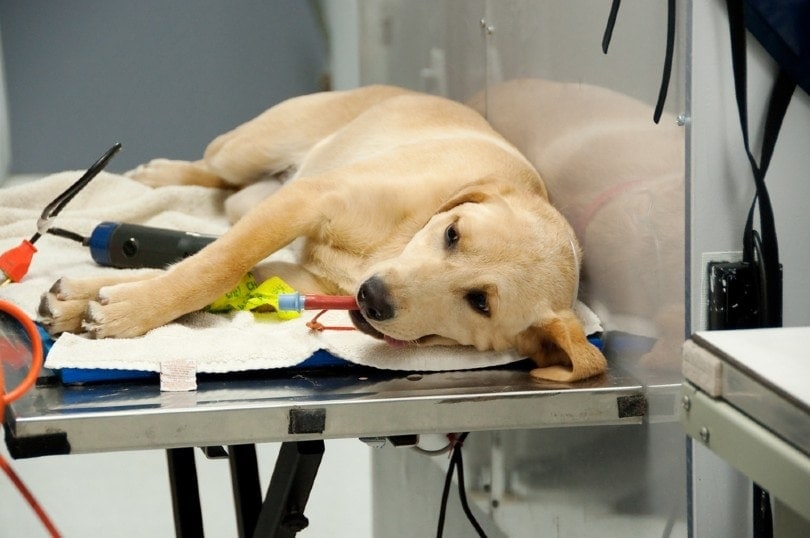
2. 32 states legally require adopted pet cats and dogs to be sterilized.
(Animal Legal & Historical Center)
The overpopulation of homeless animals is a common issue in many cities. Many states have responded to this issue by requiring animal release agencies, such as animal shelters and animal control centers, to spay or neuter sexually mature cats and dogs.
Most state laws do provide exceptions for special circumstances. For example, some states do not require cats and dogs to be sterilized if they’re released to the US armed forces or law enforcement agencies.
3. Spaying and neutering cost between $320 and $550 from a private clinic.
(The Dodo)
The average costs of spaying and neutering cats and dogs are several hundreds of dollars. Pet owners can save on costs by enrolling in a pet insurance plan that covers sterilization surgeries. Spay and neuter clinics for low-income families can also reduce costs with proof of income documents.

Effects of Spaying & Neutering on Animal Shelters
4. Approximately 6.3 million animals enter US animal shelters annually.
(ASPCA)
Animals can become homeless for a variety of reasons, but cats and dogs that haven’t been sterilized can quickly add to the number of stray animals. Spaying and neutering are effective means of reducing stray or feral cats and dogs, which would prevent overcrowding in animal shelters and rescues.
5. About 920,000 shelter animals are euthanized annually.
(ASPCA)
Unfortunately, one of the reasons animal shelters euthanize animals is overcrowding. However, the rate of euthanized animals is slowly declining as more animals are getting sterilized and adopting pets is becoming popularized.
Many animal control agencies also participate in Trap, Neuter, Return (TNR) programs, which will sterilize animals that have been captured before releasing them back outdoors.
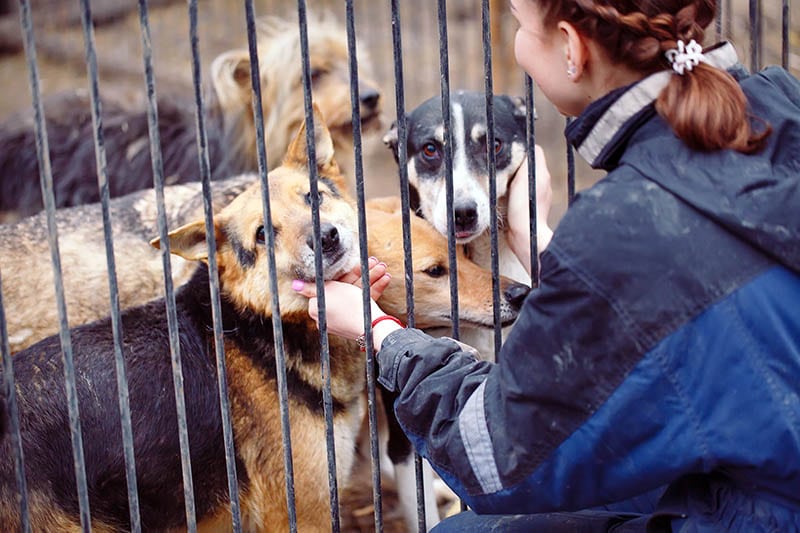
6. The percentage of stray cats entering shelters lowered from 54% to 50% in 2022.
(Shelter Animals Count)
The number of stray cats entering animal shelters has slowly declined since 2019. In 2019, about 54% of animals entering shelters were cats. It’s speculated that TNR programs are contributing to these efforts, but more time and data are required to figure out the exact effects of TNR programs.
7. Almost 5,000 kittens can be born from one unspayed female cat in 7 years.
(SNAP)
Leaving cats and dogs intact can quickly multiply the stray animal population. One female cat can potentially raise nearly 5,000 kittens in 7 years, while one female dog can have up to 508 puppies in 7 years. So, spaying female cats and dogs can help slow down the growth of stray animals and reduce the number of homeless pets over time.

Health Data Related to Spaying & Neutering
8. 75% of bite reports involve an intact male dog.
(SNAP)
While neutering a dog doesn’t guarantee more docile behavior, there seems to be a correlation between aggressive behaviors and intact dogs. Intact dogs may be more likely to engage in dominance aggression and may be more territorial than neutered dogs. They’re also more likely to roam and be more difficult to housetrain as they urine mark more frequently.
9. 85% of dogs hit by cars haven’t been spayed or neutered.
(SNAP)
Dogs that haven’t been spayed or neutered have a higher chance of roaming, especially during mating season. They may try harder to escape as they look for a mate and can end up wandering on busy streets with cars.
Dogs that have been sterilized may still escape the home, but it would be for reasons other than roaming and searching for a mate.
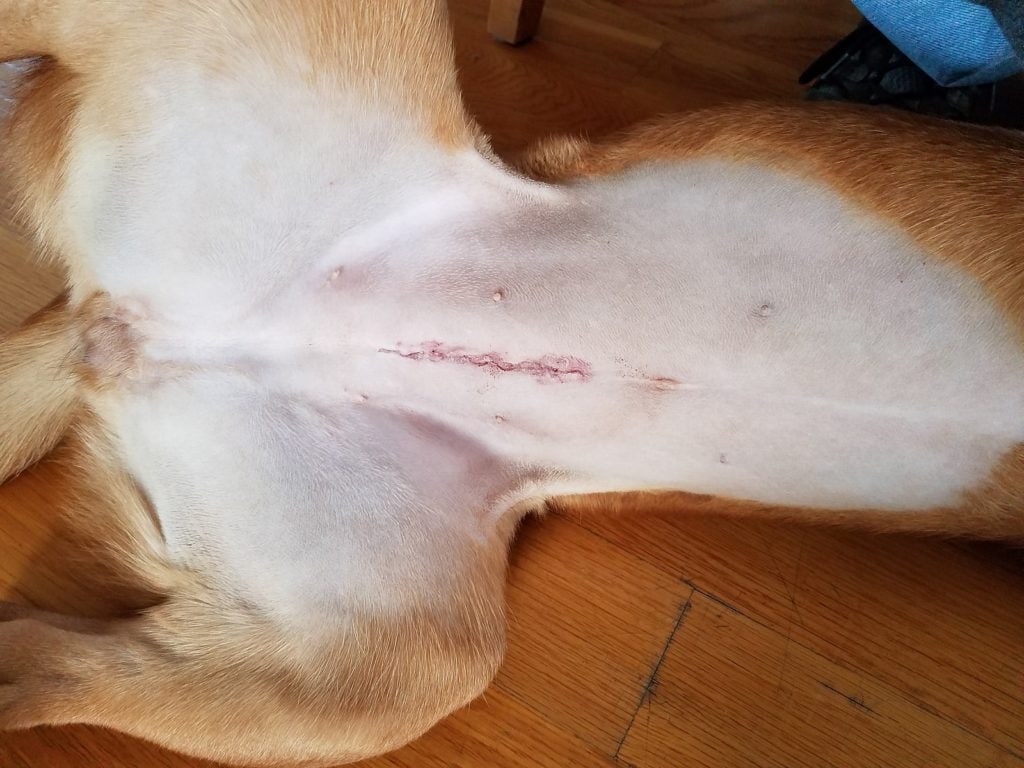
10. Neutered dogs live 18% longer and spayed female dogs live 23% longer than dogs that haven’t been sterilized.
(The Humane Society)
It’s unclear as to exactly why sterilized pets live longer than unaltered pets. It could be that unaltered pets are more likely to roam and act territorial. So, they’re more prone to getting into accidents, and engaging in fights with other animals can expose them to infectious diseases.
Sterilized pets are also at a lower risk of developing certain types of cancers and health issues as they age.
11. Dogs that are spayed before their first heat cycle have an 0.5% increased risk of developing mammary cancer.
(CARE)
More in-depth research is revealing that the timing of spaying dogs is important. One study shows that dogs that were spayed before their first heat cycle had a lower risk of developing mammary cancer than dogs that were spayed between their first and second heat cycle. Female dogs that were spayed after their second heat cycle didn’t see much change in risks of developing mammary cancer than unaltered female dogs.

12. Male Golden Retrievers that were neutered before 12 months old were twice less likely to develop hip dysplasia than intact males.
(CARE)
The timing of neutering male dogs also seems to have an effect on reducing risks of certain health issues, but researchers are still looking for the exact relationship between neutering and a dog’s age. Future health risks may also vary among different dog breeds.
So, male Golden Retrievers that have been neutered before 12 months old may have a lower risk of developing hip dysplasia. However, male Golden Retrievers that have been neutered at less than 6 months of age have an increased risk of developing an orthopedic disease.
Frequently Asked Questions About Spaying & Neutering Cats & Dogs
What happens when a cat or dog is neutered or spayed?
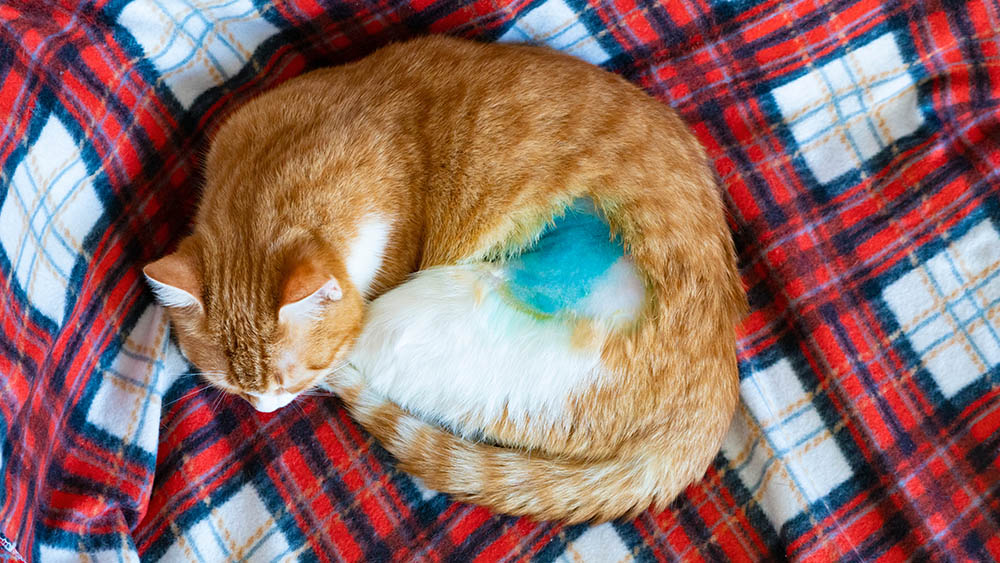
When a female animal is spayed, they often have an ovariohysterectomy. This procedure removes the ovaries, fallopian tubes, and uterus from a female dog or cat. Veterinarians can also perform a hysterectomy, which removes the uterus and parts of the fallopian tubes. The ovaries remain in the body and continue to produce hormones that preserve the animal’s breeding instincts and behaviors.
Another spaying procedure is an ovariectomy. This removes the ovaries but keeps the uterus inside the body. Cats and dogs that get an ovariectomy won’t have a heat cycle or engage in mating behaviors.
Male cats and dogs often get an orchiectomy, which removes the testes and reduces breeding behaviors. They can also get a vasectomy, which only removes the vas deferens. Male cats and dogs will still have testes that produce hormones, and they may engage in breeding behaviors. (AVMA)
When should cats be neutered or spayed?
It’s safe for most kittens to be neutered or spayed between 8 weeks old and 5 months old. Cats can also be sterilized when they’re adults. It’s best to consult your veterinarian to determine the best time to sterilize your cat. Unlike dogs, there isn’t much evidence of health risks associated with the age and timing of cats getting neutered or spayed.
When should dogs be neutered or spayed?

Traditionally, dogs get neutered or spayed when they’re 6 to 9 months old. Older dogs can get neutered or spayed, but they do face higher risks of postoperative complications. Since dog breeds reach sexual maturity at varying times, veterinarians may recommend different ages for them to get neutered or spayed. So, it’s important to consult your veterinarian before scheduling a procedure for your dog.
Does spaying and neutering cats and dogs cause obesity?
Spaying and neutering pets won’t directly cause weight gain, but they can put them at higher risk of obesity. This is because sterilized pets aren’t likely to roam or be as active as intact pets when they’re acting on their breeding instincts.
As long as you give your pet a healthy diet and meet its daily exercise needs, it shouldn’t experience significant issues with weight gain. If your pet does start to gain weight, it’s often best to visit your veterinarian to determine the underlying cause of weight gain.
Are there cases where I shouldn’t have my pet neutered or spayed?
Regarding cats, there isn’t enough evidence to prove that neutering and spaying have significantly negative effects on cats’ health.
However, research is showing that it’s not appropriate for all dogs to get neutered or spayed. For example, some dog breeds may be at higher risk of developing joint issues later in life if they’ve been sterilized. Older dogs may also experience further health complications if they get neutered or spayed later in life.
So, it’s important to consider your dog’s age, breed, and predisposition to health issues. Current and ongoing research on the impact of sterilization can provide more clarity, but it’ll take more time before we receive definitive answers. (AKC)
Conclusion
Neutering and spaying cats and dogs are common practices in the US. Most pet experts recommend spaying and neutering pets if you don’t plan to breed them. This can reduce the number of homeless cats and dogs and prevent overcrowding. Spaying and neutering can also lower the risks of certain illnesses. It’s important for dog owners to pay more attention to the timing of the procedure to prevent health risks.
Featured Image Credit: De Visu, Shutterstock












